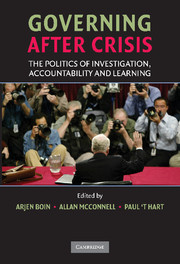Book contents
- Frontmatter
- Contents
- List of illustrations
- List of tables
- Contributors
- Introduction
- Part I Crisis-induced accountability
- 2 Weathering the politics of responsibility and blame: the Bush administration and its response to Hurricane Katrina
- 3 A reversal of fortune: blame games and framing contests after the 3/11 terrorist attacks in Madrid
- 4 Flood response and political survival: Gerhard Schröder and the 2002 Elbe flood in Germany
- 5 The politics of tsunami responses: comparing patterns of blame management in Scandinavia
- 6 Dutroux and dioxin: crisis investigations, elite accountability and institutional reform in Belgium
- Part II Crisis-induced policy change and learning
- Conclusion
- Index
- References
2 - Weathering the politics of responsibility and blame: the Bush administration and its response to Hurricane Katrina
Published online by Cambridge University Press: 04 June 2010
- Frontmatter
- Contents
- List of illustrations
- List of tables
- Contributors
- Introduction
- Part I Crisis-induced accountability
- 2 Weathering the politics of responsibility and blame: the Bush administration and its response to Hurricane Katrina
- 3 A reversal of fortune: blame games and framing contests after the 3/11 terrorist attacks in Madrid
- 4 Flood response and political survival: Gerhard Schröder and the 2002 Elbe flood in Germany
- 5 The politics of tsunami responses: comparing patterns of blame management in Scandinavia
- 6 Dutroux and dioxin: crisis investigations, elite accountability and institutional reform in Belgium
- Part II Crisis-induced policy change and learning
- Conclusion
- Index
- References
Summary
Introduction
As forecasters and policy makers watched Katrina grow ominously in strength from a Category 4 hurricane (with sustained winds of 145 mph) into a Category 5 storm (with 160 mph winds) on 29 August 2005 (the day before its eventual landfall over Mississippi and Louisiana), the worst fears of many seemed about to be realised. For decades, planners had warned that New Orleans, with its vulnerable levee systems and bowl-shaped geography, would be at great risk of massive flooding and loss of life if struck by even a weaker Category 3 storm (120 mph winds). Indeed, emergency officials from federal, state and local jurisdictions in July 2004 had conducted a five-day training exercise at the State Emergency Operations Center in Baton Rouge in which a hypothetical Category 3 hurricane named Pam struck New Orleans. The results demonstrated not only that officials at all levels were unprepared to cope with such an event but also that only one-third of the city's population would be evacuated owing to lack of transportation, the city would likely flood and potentially tens of thousands of people would die (globalsecurity.org 2005). These results were reported to policy makers at all levels of government, including the White House. Yet only a year later, when the very real Hurricane Katrina slammed into New Orleans, government officials at all levels seemed surprised to learn that the levees had been breached (leaving 88 percent of the city submerged) and were largely unable to marshal any kind of effective emergency response after the storm had passed.
- Type
- Chapter
- Information
- Governing after CrisisThe Politics of Investigation, Accountability and Learning, pp. 33 - 61Publisher: Cambridge University PressPrint publication year: 2008
References
- 11
- Cited by



